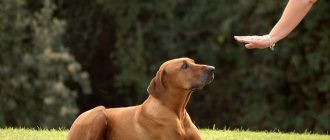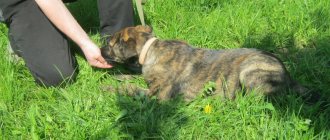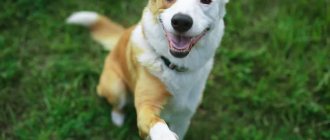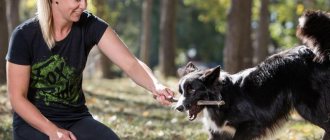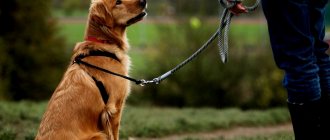Is it necessary to master the “alien” command?
This command is not always required, and the owner must first weigh everything: whether the pet needs to develop aggression, and whether the owner himself has enough strength and influence to control its manifestations.
Incorrect training, especially when it comes to dogs with an unbalanced psyche, can lead to the animal growing up angry and uncontrollable. Experienced breeders and dog handlers note a number of features:
- Large service dogs, even without additional training, rush to protect their owner if a dangerous situation arises, especially if their relationship is based on friendship and trust.
- Owners of dogs of decorative breeds will not receive any benefit from training such a command. It is unlikely that a tiny Chihuahua or lapdog will cause fear in anyone, even if they bark furiously.
- If improperly trained, a dog can show hostility towards its owner or family members; naturally, such an animal is very dangerous.
Among the positive aspects, it can be noted that the pet will not fawn and trust everyone passing by or entering its territory.
Train a dog to be mean to strangers
Sometimes it is necessary to teach a pet to be angry towards strangers, and also to teach it to bark at strangers. Such methods are used by the owners of private houses and various enterprises where strangers may enter. When a dog has close contact with its owner, sometimes there is no need to cultivate anger. But in most cases, owners turn to a dog handler for help. Only a specialist can help set up training correctly.
Before this, the dog handler must warn that such a command can be dangerous for people around him, that you need to understand the seriousness and know how to pacify the dog. You need to teach an animal to be angry towards strangers from a very early age. By the age of 4 months, the dog should already know the commands “fu”, “come to me”, “stranger”. With the help of a dog handler, you will teach her to be aggressive when you order her. By teasing the dog and catching it, the dog handler will show by his own example that a stranger is dangerous and that action must be taken immediately.
After such activities, you need to behave calmly and restrainedly, praise your pet and give various treats. An experienced trainer will teach you how to develop anger and be wary of strangers after just 5-7 lessons. The main thing is to deal with aggression correctly and quickly calm the animal after such actions.
Training scheme
It is worth immediately taking into account that it will not be possible to train a pet alone - you will need helpers, and not close ones or relatives. Ideally, such training is best done with the assistance of an experienced instructor. A professional will be able to immediately assess whether the dog is suitable for learning such skills.
Another important nuance - if the owners know from the first days that their pet will master such serious commands, then from the first days it is recommended to protect it from contact with strangers. That is, it is forbidden for strangers to play and stroke the baby. People coming into the house are warned not to show increased attention to the pet. Already in this case, you can pull the puppy by the leash and say the command “stranger”.
When the dog has grown up, become stronger, and mastered basic skills, you can begin specific training - distrust, anger towards strangers. It is necessary to find several assistants and provide them with a special protective kit. Like other training, training is carried out in a quiet, familiar place, without any distractions. This process includes the following steps:
- The dog must be restrained using a short leash (see how to train a puppy to use a leash).
- The assistant must approach the person with the dog and show aggression towards them - swing his hand or stick, but at the same time he must show with all his appearance that he is afraid of the dog.
- Without letting the dog off the leash, the person gives the command “stranger”, using intonation that warns of the existing threat.
- Any hostile reaction - the dog growls, barks, grins, tries to attack a stranger - is encouraged, but the command must first be repeated.
Then you need to take a break so that the dog calms down, rests and comes to his senses, and then repeat the procedure. It is not recommended to overload the dog - two or three approaches per session are enough.
- we teach the dog to fetch a stick;
- where to start training a puppy.
What if the dog doesn't want to show aggression?
Quite often, owners are faced with the fact that their pet does not show aggression towards a stranger. But in this case, you should not immediately retreat and use more active methods:
- the assistant does not wave his hands, but tries to attack the owner;
- he tries to take away from the owner a treat intended for the pet;
- “attacking”, the helper lightly hits the dog, not to cause bodily harm, but to provoke aggression.
Dog handlers warn that excessive use of physical violence can have the opposite effect - the dog will become not angry, but cowardly. The assistant is required to have an attentive and careful approach - he must observe the dog’s behavior and, if necessary, stop training. This is done so that the person does not suppress the dog - in this “fight” the animal must always win!
Encouragement is important - for the expected reaction the dog is petted, words of praise are spoken, and a treat is given. But it is advisable not to overdo it with the last point. You can also reinforce the result when walking - the command is pronounced if the pet begins to growl or grin at a passerby. During walks, you can also provoke the dog - ask the assistant to quietly approach the dog when he is not expecting it, and pat him, for example, on the rump. The owner gives the command at this moment.
With the right approach, after some time, the dog develops the necessary reaction - he shows distrust of strangers and does not feel fear when they swing at him.
Teaching your pet the “stranger” command is an event that requires a serious approach. If the owner is not ready for consistent work while observing a number of rules, then there is no point in starting. After all, it is not difficult to harm a puppy’s psyche, but it is not possible to correct the situation in certain situations. No confidence in your own abilities? Then it is better to contact an experienced dog handler.
Possible mistakes
- Continuation of work if the dog begins to show cowardice or uncertainty. Do not work with a pet who is not confident, otherwise, with the wrong approach, you will only aggravate the situation. You must work on the animal's stability before you begin teaching the "face" command.
- Manifestation of excessive emotionality. Do not scream or make too loud or emotional sounds, otherwise the dog will regard this as panic and will not show the desired reaction. You must act confident.
- The pronunciation of the command “alien” is just like that . Don't make your pet nervous for no reason. If you tell your dog “stranger” for fun, it may begin to show aggression towards others. In addition, over time, the pet will get used to this word and begin to ignore it.
How to raise a defender
The difference between the commands “alien” and “fas”
When starting training, you need to clearly distinguish between the commands “alien” and “fas”. The owner's cry of "stranger" means a danger signal. The dog should be alert and react by growling or barking at a stranger or stray dog, without trying to attack first. The animal protects itself and its owner.
The "fas" command is the next level. Hearing her, the animal itself rushes at strangers and bites them. This command is taught to pets of service and guard breeds, and after they have completed the OKD (basic training course). The pet must first learn to clearly follow the commands “fu”, “near”, “come to me”, “lie down”, “sit”.
In our case, the dog must become angry at strangers, that is, learn to carry out the “stranger” command.
Teaching Methodology
It should be remembered that a dog, especially a service dog, poses a certain danger to others. Therefore, her training should be approached with all responsibility. The dog should show aggression if:
- on the street the owner is threatened by an inappropriate stranger;
- there is a threat of attack by a stray animal;
- Intruders are trying to break into a house or car.
Team training starts at home. You need to ask someone to knock on the door. The animal’s natural reaction will be to bark, and the owner should clearly say “stranger” while praising the dog. To consolidate the result, you need to do several repetitions of these actions.
The next stage is outdoor activities. The helper approaches the dog and the owner with a stick in his hand and begins to behave aggressively: screaming, waving the stick. The owner should clearly say “Stranger!” and push the stranger away. The dog will most likely growl or bark and should be rewarded, praised or petted. It is not advisable to give treats so as not to distract from the learning process. Over time, a connection will be established in the pet's mind between the command and the need to bark in such a situation.
But another reaction of the animal is also possible. The dog may become frightened by an aggressive stranger, start whining, fall on its back, or try to run away. Then the assistant should quietly come up from behind and pinch her by the fold of skin near her hind paw. Painful sensations cause a response, the dog becomes angry. When using this method, the animal must be muzzled.
When training an animal, you need to remember the basic rules:
- ZKS (protective guard service) classes should be conducted in specially designated places, on sites or, if there are none, somewhere outside the city;
- dogs from the Molosser group (Bullmastiff, Dogue de Bordeaux, Great Dane, Rottweiler, etc.) mature late (by 2-3 years) and it is worth starting ZKS classes with them already in adulthood, so as not to cause harm to the fragile psyche and make the dog overly aggressive or uncontrollable;
- You cannot involve acquaintances, and especially family members, as a “villain”; the pet may begin to perceive them as enemies in everyday life;
- you need to start classes only when you are confident in the unquestioning obedience of the animal in order to stop it if necessary, for example, when trying to attack an imaginary attacker;
- the learning process on the street should be made safe for the assistant and passers-by; the pet should be kept firmly on a leash.
Timely training of a Rottweiler will help the owner keep it under control. Dogs of this breed need courses to develop certain skills. Otherwise, it will not only be impossible to use the Rottweiler as a service dog, but even to go outside with it. In this article we will introduce you to the basic training courses that a Rottweiler is supposed to know.
Teaching a dog to bark at strangers
Almost all breeds can learn to bark at strangers. Well amenable to training:
- German Shepherd;
- Rottweiler;
- Staffordshire Terrier;
- Boxer and other fighting dogs, as well as protectors.
Such breeds by nature react by barking at strangers. When training them, at the moment of barking, the main thing is not to stop performing certain actions, but, on the contrary, to force them to bark even more and longer. To do this, you need the help of strangers who are not familiar to the animal. During training, the pet must be on a leash so as not to harm people. Upon completion of the training, the owner must say “ugh” in a calm voice and pet the animal. You need to achieve such a result that when you appear, the dog stops barking.
Basic rules of training
So that the dog can be safely trained, it is necessary to show it from the first meeting who is boss in the house. Rottweilers will only obey the leader - the leader of the pack. It is necessary to determine once and for all the boundaries of what is permitted for the animal and never deviate from your decision. Otherwise, the Rottweiler will grow up willful.
Having given the dog a command, it is necessary to ensure its complete execution. You cannot move on to the next one until the previous one has been thoroughly studied. Jumping from command to command can not only confuse the dog. For a Rottweiler, an order may become meaningless and she will refuse to carry it out.
If a dog does something wrong, it does not mean that he is stupid or disobedient. In most cases, erroneous execution of commands or actions is the result of poor or incorrect training.
During training, you need to monitor the physical and mental state of the Rottweiler. Any strange behavior in the dog, excessive excitability or anxiety is a reason to skip the lesson, giving the animal time to rest. If your Rottweiler is not feeling well, it is best to consult a veterinarian for advice. Perhaps he got sick. In case of illness, training can be continued only two weeks after the animal has fully recovered.
It is necessary to communicate with the dog in a language it understands, showing the expediency of the task. All commands must be short and given clearly, quickly, with a certain intonation. The rewards discussed below will tell your Rottweiler that he will receive a reward if he obeys.
Demanding the impossible from your pet can tire him out, make him angry and disappoint him. In any case, the dog may stop obeying its owner. The requirements must be commensurate with the capabilities of the animal.
You cannot deceive your dog during training. If you give the Rottweiler the command to “walk” and instead of the promised walk you give him an injection, most likely he will stop trusting the deceiver. Training will turn into a burden if the trusting contact between the owner and the dog is broken.
You need to carefully monitor the “purity” of the dog’s execution of the command. If you ignore the incorrect position of the Rottweiler after the “sit” command, it will subsequently be difficult to teach him an even exhibition stance.
Training should be enjoyable for both owner and dog. Therefore, it is better to carry it out in the form of a game and in the fresh air. Usually a day you work with the dog three to four times for fifteen minutes. The time and number of classes may vary under the influence of various factors: poor health of the dog or owner, unsuitable weather conditions, and so on.
It is advisable to end each lesson with a command that the Rottweiler knows well. After correctly executing the command, the dog must be praised and treated with a treat. In this case, both the owner and the pet will have a pleasant feeling of achieved success until the next training session.
Reward and Punishment
From the very beginning of training, treats can be used as a reward to practice commands. For each correct execution of a command, the dog is rewarded with his favorite food: pieces of apple, low-fat cheese, dry food granules. Rottweilers have a highly developed reaction to food. Therefore, the treat helps to quickly consolidate the necessary skills and retain them in the dog’s memory.
Reward in the form of treats establishes a trusting relationship between the owner and the Rottweiler. Food also keeps the dog active during training. As a result, she feels good, despite the fatigue after classes. For the treat to help with training, the dog must be half-starved. Training should begin three to four hours after eating.
Instead of treats, you can use petting and friendly pats. It all depends on what the Rottweiler likes best. The dog will gladly follow the trainer's commands if there is a reward waiting for it.
At five to six months, the Rottweiler may begin to show temper and get out of control. If treats and friendly gestures no longer help in training, you will have to punish him for disobedience.
The main punishments for a Rottweiler include being lifted from the ground and lightly shaking, covering the animal's muzzle with a hand for a short period of time, a severe reprimand, and lack of encouragement.
The main thing in punishment is not to overdo it. If the owner causes the Rottweiler severe pain and shows him his anger, the dog may become angry in response. It is very difficult to get the animal back under control.
General training course
From six to twelve months, you can prepare a Rottweiler to pass the official standards for OKD - a general training course.
During the exam, it is checked how the Rottweiler sits down on command, lies down, approaches the owner and returns to his place, brings an object, stops an unwanted action, does not pick up scattered food from the ground, and shows his teeth. The dog is checked for endurance, attitude towards the muzzle and leash. By order of the owner, the Rottweiler must, without delay or fear, go through an obstacle course: low and high barriers, stairs and others.
After practicing any command of the judge's choice, the Rottweiler's attitude to the shot from the starting pistol is checked. You cannot shoot while the dog is moving near the owner or while an object is being presented. The shot is fired at a distance of fifteen meters from the dog. For the shot to be sudden, the animal must not see the person with the gun.
Throughout the test, the judges evaluate their impression of the overall performance that the dog was able to demonstrate.
Protective guard service
ZKS (protective guard service) is a special training developed by Soviet dog handlers. The training is aimed at developing the dog’s security and protective functions, as well as the ability to follow a scent and search for various objects by smell. A special course is used in law enforcement agencies to train dogs for guard, search and other services.
However, such a course is not entirely appropriate in everyday life. Therefore, the amateur ZKS course is becoming increasingly popular among Rottweiler lovers. With its help, dogs are trained to protect the owner, his family, property and home.
After completing the course, the Rottweiler acquires the skills to detain a criminal and guard him until the owner arrives, to keep the situation under control, without reacting to any sounds, thrown food, or bright light.
To take the ZKS course, the Rottweiler cannot be younger than twelve months. The dog must be mentally and physically healthy, without external defects, such as an incomplete set of teeth, poor eyesight or hearing.
In addition, for the amateur course it is necessary that the Rottweiler unquestioningly carry out basic obedience commands. For a special ZKS course, it is necessary for the dog to successfully pass the OKD exam (general training course) and receive a certificate from the RKF (Russian Canine Federation).
Manageable city dog
If there is no opportunity or desire to take official exams on a general training course with your Rottweiler, you can train your Rottweiler in the UGS course - a controlled city dog. Unlike OKD, where the assessment of completed tasks will be given by specialists of the Russian Canine Federation, the UGS course is held in any dog breeding club. Therefore, instead of an RKF certificate, the owner of a Rottweiler can only receive a club diploma.
Taking a city dog management course is especially recommended for owners who live in the city and constantly appear with their Rottweiler in public places. Training begins at six months.
The UGS course is designed to develop a Rottweiler into a companion who knows how to behave correctly in city conditions. However, there are more requirements in this course than in OKD. After all, work with dogs is carried out not only in closed dog parks, but also in other areas where there are many unpredictable urban factors and outsiders.
After completing the UGS course, the Rottweiler will learn the following:
- follow the commands “near”, “sit”, “lie down”, “stand”, “come to me”, “no”, “fu”;
- treat walking accessories calmly: leash, muzzle;
- do not show signs of anxiety during a manual examination of teeth, fur, ears, paws;
- calmly go out or enter the entrance, car, clinic, and so on;
- calmly cross an overground or underground pedestrian crossing;
- be comfortable on public transport;
- do not accept food from strangers;
- do not pick up food or dirty objects from the ground;
- wait for the owner on a leash in public places;
- overcome an obstacle course;
- concentrate attention on the owner;
- do not react to city noises.
In addition to the UGS course, an already one-year-old Rottweiler can take the ZGS course - a protective city dog. In addition to the skills of the dog, the dog will learn to obey while practicing protective functions, to grab an attacker on the command “face” and release on the command “throw it”, to repel an attack on the owner or other family members, to detain and escort an escaping person.
Like the UGS rate, the USG rate is not official. After passing it, the Rottweiler will receive a diploma from the Kennel Club.
The German Shepherd is a service breed dog whose main characteristics are a high level of intelligence and people-oriented behavior. Thanks to this, teaching your pet commands will not be difficult even for those who have not trained a dog before.
It is important to know
You need to repeat the training of any team 4-5 times in one approach; during the whole day, you need to do about 3-4 approaches to consolidate it. You need to start teaching any commands before feeding, so that praise with a treat has a strong positive effect. Learning a new command begins only after finishing practicing the previous one.
In the same way, you can teach an adult dog commands. But in this case, it is quite expected that more time, patience and perseverance will be required. If the pet has obvious behavioral disorders, it is advisable to coordinate any training with a dog trainer. In general, you can teach a dog commands in 3-5 days, depending on the breed, age of the pet and your persistence.
Video on the topic
The main characteristics of which are a high level of intelligence and human focus. Thanks to this, teaching your pet commands will not be difficult even for those who have not trained a dog before.
How to teach a German Shepherd commands?
Accustoming to basic exercises should begin from the first day the puppy is in the house. To avoid any difficulties, the pet owner should adhere to the following rules:
At the initial stage, classes are conducted in a calm environment; the puppy should not be distracted from training by surrounding factors - passers-by, cars, other animals, etc.
It is allowed to give the dog treats (small pieces of cheese, food or other food that is safe for the pet) - this will be an incentive to perform the actions correctly.
Training is carried out before feeding, and not after it. A well-fed dog is more difficult to motivate to follow commands with treats. To consolidate the skill, 12-15 repetitions in one lesson are enough, but they are carried out in several approaches, and not in a row.
The process of teaching a puppy commands should alternate with games so that interest in classes is not lost. If your pet lives not in a house, but in an enclosure or kennel, then you need to take into account that he spends much more energy on activity than a domestic dog
Important! Teaching a pet is much easier than retraining it, so when practicing basic commands, you should ensure perfect execution every time and only then reward your pet.
Basic
The earlier training begins, the more impressive the results will be. You can start learning basic commands from the very first day the puppy is with the owner.
It is the impeccable execution of basic commands that will help the owner avoid unpleasant situations (for example, the indignation of a passerby whose clothes have been soiled by a running puppy) and will ensure the safety of the pet itself (in particular, the “come to me” command will force the dog to run up to the owner, and not go out onto the roadway).
The list of basic commands is small, but each of them must be carried out by the dog without delay. The first thing you should teach your shepherd dog is the “come to me” command. It is given by the owner when the pet needs to be called.
To accustom it to it, you should say “come to me” when the dog is called for feeding, to pet or play with it, and so on - that is, the shepherd dog must know that after approaching it will receive a pleasant reward. After the Kafka dog came up and received praise, it was released with the word “walk.”
Important! You cannot punish a dog if it does not immediately run up to the owner, and it is also prohibited to independently move towards the puppy. As soon as your pet approaches, you should immediately praise him and treat him with a treat.
“No” and “Fu” are used by owners to stop unwanted actions of the pet. It is better to practice them in a confined space or while keeping the dog on a leash. In the first case, a dog performing an undesirable action is punished with a gentle slap (for example, with a rolled up newspaper) and a spoken word, and in the second, with a sensitive tug of the leash, and the action is accompanied by a command.
The owner needs to be consistent - he should not allow the dog at a young age to do things that would be prohibited for an adult pet.
The algorithm for teaching a shepherd dog other commands is as follows:
- “Sit” - the puppy stands in front of the owner, who has a treat in his hand. The owner holds the hand with the treat above the dog’s head, while simultaneously pressing the puppy’s croup with the other hand and says “sit.”
- “Lie down” - performed by the dog from a sitting position. The owner passes his hand with a treat clamped in it in front of the dog's muzzle forward and down to the ground. Actions are accompanied by a single pronouncement of the command word.
- “Nearby” - the puppy is led on a leash so that the front part of its body is in line with the owner’s leg, and when the owner stops, the dog must sit down. Attempts to move away from the owner are stopped by a jerk of the leash, and correct execution is encouraged.
Important! Practicing basic exercises begins with 1-3 repetitions, and over time their number increases. The main thing is to finish classes before the puppy gets tired, then he will not lose interest in training
A puppy should not be taught the “voice” command from early childhood, since the really important skills have not yet been learned and wasting effort and energy on this training will take a lot of effort from the baby.
How to stop a dog from taking food from strangers?
- Only the owner feeds. It is important! Don’t even let your friends pamper “such a cute fluffy little furball” with goodies.
- Weaning off picking up from the floor. First of all, you need to wean yourself from picking up food from the ground, and only then teach the dog not to take food from strangers. Read more about weaning in the article at the link. By the way, before 3 months you can’t wean him off picking up from the floor and, especially, from someone else’s hands.
- Teach a puppy from 3 to 5 months not to take food from someone else's hands as follows. Place the puppy near your left leg, saying “sit” (for this you need the command to sit). Ask your friend or acquaintance to offer the puppy a piece of tasty food (sausage, smoked sausage, etc.) and hold it near the puppy’s nose for 5-10 seconds. As soon as the puppy tries to take food, give a strict command “fu” and jerk the leash towards you.
- Have your friend offer food to the puppy again. Did he try to eat her again? Then say “ugh” again and give an even more severe jerk with the leash. To quickly achieve results, try to understand how to teach your dog commands using a mechanical stimulus. The jerk should be strong enough so that the next time a friend offers food, she thinks: “If I take the food, I’ll get it in the neck from the owner.” I’d rather not take it.”
- It's rude, but we don't do it out of malice! If the puppy refuses to eat next time, be sure to give him an even more delicious treat from your hands. The animal must know that if the owner refuses to take it from someone else’s hands, it will receive something much tastier.
Puppies from 5 months and adult dogs wean themselves from taking food from strangers using more aggressive methods. Let your friend, preferably not the person the dog sees often, offer a piece of treat from your hand and hold it under the dog’s nose for 10-15 seconds. As soon as the dog tries to take the food, he will immediately receive a noticeable slap in the face. Don’t overdo it with force, find the “golden mean”. If the dog tried to eat it again after giving food to strangers, let the helper slap him even harder.- You must stand with the dog next to your left leg the entire time. If the animal turns away from the offered treat, have the helper move a few steps back, and you generously praise the dog and give a tasty treat.
- If the animal gets up and hides behind you in response to the food offered by the helper (for 10-15 seconds), let the helper step back, and you praise the dog with a treat. It's already very good that she doesn't take food.
- If a dog behaves aggressively in response to an offered treat, then the owners of breeds that are not characterized by aggression should not be too strict, but prohibit aggression with the command “fu”. Make sure that the dog may growl, but does not rush at the person.
- For example, a helper offered food, and the dog began to growl for it - encourage it and give treats. If she rushes, also reward with your voice, and after rewarding (after 4-5 seconds), sit the dog near your left leg with the command “sit”, and then praise generously again and give a tasty treat. Learn to control any dog aggression, otherwise you will be in trouble!
That is, refusal of food should be encouraged even if the dog behaves aggressively. If she rushes at the helper for the offered food, for such aggression it is better to give a not very strict, prohibitive command “fu” instead of a treat. Thanks to the persistent actions of the owner, the dog will understand that there is no need to react to the offered treat with an attack. Owners of serious breeds intended to protect the owner and protect them must encourage the pet’s aggressive behavior in response to a treat offered by a stranger.
How to teach a shepherd the command “Alien!”
Before starting home exercises, the animal must undergo a general training course (GCD). By the time you learn the command “Alien!” The dog must have good endurance and obedience. It is then that the animal becomes absolutely ready for training to protect and protect humans.
Team “Fas!” or “Alien!” belongs to a complex and rather dangerous team. Especially when it comes to more serious dog breeds: Central Asian and Caucasian Shepherd Dogs. You can teach a dog defense when it has good endurance and unquestioning execution of other commands.
You can start working with a German or East European Shepherd (VEO) puppy from 6-9 months, and with an adult - from absolutely any age. As for Alabai and Asians, it is recommended to start the training process with them as early as possible. It is important to show the dog from puppyhood who is boss in the house. Otherwise, the dog will be difficult to control in the future.
Don't forget, shepherds have a strong predatory instinct, so you need to be careful when training.
You can train a shepherd dog with the help of an experienced dog handler, or you can start training yourself, but with the help of a brave and reasonable assistant.
Training equipment
What you will need for training:
- a person who will initiate an attack on the owner;
- protective clothing;
- strong leash;
- rod and durable fabric.
Before starting any activity, the dog needs to expend accumulated energy and relieve itself, then it will be completely focused on its owner.
You should work in an area where there are no factors that can distract you from training—a forest or a stadium would be an excellent option.
Learning process
You can teach a German Shepherd a foreign command as follows:
- The animal is tied tightly to a tree on a short leash. It is important to provide the dog with free movement so that it can move from side to side.
- The owner, or the one who will train the dog, must stand next to the animal, the attacker remains aside.
- Next, the assistant needs to approach the owner and start behaving aggressively: actively waving his arms, raising his voice, hitting the ground with a rod. Thus, the dog must understand that the owner is in danger.
- The next step is for the owner to loudly and clearly give the “stranger” command. In most cases, already at this stage the animal will take the initiative to protect the person. The German Shepherd is one of the few breeds that lends itself well to training this command.
- After the dog begins to actively show aggression towards the attacker, it should be rewarded. It’s enough to pat the dog on the head and say “well done” or “good” (depending on what word the dog was praised during OKD). It is worth taking into account: when an animal is being trained, it is praised and rewarded with food, but during training for the defense command, it is absolutely forbidden to feed it; ordinary praise is enough.
- The training does not end there; force is then used. The attacker tries to show aggressive behavior towards the animal: lightly hit with a rod (not causing pain, but only discomfort), while simultaneously waving a thick cloth. When a dog tries to bite a person, a cloth is presented to it. During the fight, the owner periodically repeats the command and always praises the correct execution. At the very end, the aggressor shows defeat and runs away, to which the dog again receives praise.
- To consolidate the team, the training process is repeated several more times.
By doing everything strictly according to the instructions, you can quickly train a German Shepherd and achieve the desired result.
Stopping aggression
Before teaching an animal to attack people, you should completely subjugate it to your will. In the process of fighting with another dog or person, the dog gets so carried away and forgets about everything that it is impossible to calm him down.
It is very difficult to switch dogs that have never participated in fights before, temperamental and choleric animals to carry out prohibiting commands. Therefore, in the German Shepherd courage test, not only the strength of the grip and the lightning-fast reaction to a threat are taken into account, but also the ability to let go of the criminal’s hand at the owner’s command.
You will need
- A vacuum cleaner, a hairdryer, a favorite toy, a piece of something tasty, a musical instrument, a brave enough acquaintance, overalls, a familiar dog handler.
Instructions
Try to “bark” at the dog yourself and provoke a response from it.
Take the toy and don't give it back until she starts barking. Show her something tasty or her favorite ball, tease her and don’t give her back until she, having lost patience, barks. Then give the command and praise for its execution, give back what you were hiding. You need to have time to give the command when the dog has already opened its mouth, but has not yet barked. With repeated repetitions, the dog will soon understand what you want from him. Reward your dog for each command with some kind of treat.
If you want to teach your dog to bark at strangers, get your friend to fake an attack. In this case, the dog will understand that it needs to protect what is dear. Don't forget that special clothing is required to complete this step!
Try grabbing your dog's nose with your fingers or pretending to flick him on the forehead.
Many dogs react to certain sounds of musical instruments, some dogs howl, others bark. Such musical instruments include a children's pipe, flute, harmonica, and various whistles.
Consult a dog handler. They are experts in this field and will certainly be able to find the right approach for your pet.
You can also resort to the help of the person involved. This is the person with whose help the dog learns to bark at strangers. The helper angers the dog in different ways and thereby provokes the desired behavior.
Sources:
- How to teach a dog to bark
It is advisable to begin training any pet at puppyhood. It is during this period that the foundations of the relationship with the dog are laid. You can teach your dog commands on your own, but for the first experience, it is better to start working under the supervision of a dog trainer.
Things to consider before training a shepherd
Before starting training, the following conditions must be met:
- The person demonstrating the attack should not be familiar with the dog, and a person who does not like the animal is not suitable for training.
- During training, the attacker and the trainer should not communicate; they should be separated, otherwise the animal will not understand what is required of it.
- During training, the dog should never be hurt, only teased, irritated and caused slight discomfort. Otherwise, she may get scared, and the attempt to teach her to turn into ordinary defense, which does not mean protection. In such a situation, the dog will defend itself, but not the owner.
- There should be no children or other people in the area while working with the animal;
- After training with fabric, gradually switch to a special sleeve that is placed on the hand so that the dog can grab it.
- Remembering to praise and repeat the command is an integral part of the process.
- The last and most important point is that after a fight the attacker should always run away, this will let the dog know that he has won.
- The learning process is quite easy, but very dangerous. There is always a risk of being bitten, so it is worth remembering a strong leash so that the dog does not break loose, and a tight protective suit.
It is very important before starting to train any dog of the shepherd breed, be sure to pass the OKD, because without knowing the command “Fu!” the animal will be impossible to stop.
Basic ways to train a pet
Do not forget that service and guard dog breeds pose a danger to people around them. That is why the process of training a dog must be taken responsibly. A pet should only show aggression if:
- the owner is threatened by an inappropriate person on the street;
- a stray animal tries to attack you;
- Thieves are trying to get into your apartment or car.
Teaching the “alien” command must begin at home. Ask someone you know to knock on the front door. When the animal starts barking, the owner should clearly say “stranger” and praise the pet for its reaction. To consolidate the result, such actions must be repeated several times in a row.
Then you can move on to outdoor training. You should have a helper approach the dog waving a stick and trying to attack you. You need to clearly say “Alien!” and push the imaginary intruder. If your dog growls or barks, reward him. But do not give your dog treats, as this will distract him from the training process. After some time, the dog will develop a connection between this command and the need to respond to it.
But it should not be ruled out that the animal may react to the situation in a completely different way. It may get scared, start whining and try to hide. The helper needs to approach her from behind, pinching her strongly on the skin located near her hind paw. Pain will cause the pet to react accordingly, so it will become angry. If you decide to use the described method, be sure to put a muzzle on the dog, as it can bite a person.
When training an animal, do not forget about the existence of important rules:
- All basic training should take place in places that are specifically designed for this. If there are no such sites in your area, go outside the city.
- Bullmastiffs, Great Danes, Rottweilers and other large dogs become adults by two or three years of age. That is why it is worth starting to train them as adults. Otherwise, you will break your pet’s psyche, as a result of which it will become overly aggressive and uncontrollable.
- The role of “villains” should not be played by your friends or family members. The pet has a phenomenal memory, so he will begin to perceive them as enemies even in everyday life.
- Before starting classes, make sure that the animal obeys you unquestioningly. Only then will you be able to stop it if necessary. Do not allow your pet to independently attack an imaginary attacker, as in the future he will stop listening to you.
- The process of training in the fresh air must be made absolutely safe for your assistant and random passers-by. To do this, hold your pet tightly on a leash, not allowing him to escape.
These are the basic rules that will help you make your dog angry at strangers. Training should be regular so that the pet consolidates the acquired knowledge.
Building the right relationship with your dog
If you have a question about how to make a dog angry at strangers, you must first understand the essence of the animal. Dogs of any breed are designed in such a way that their owner is their best friend and comrade. Protecting it is their natural feature, which is inherent at the genetic level.
You should not raise a dog aggressively, beat it, scare it just to develop anger in it. On the contrary, affection, love, understanding will help you raise real defenders of your home.
Experienced dog handlers can tell you how to make a dog angry at strangers; for this you need to take special training courses. Similar clubs are located in every major city. Therefore, if a pet is new to your family, it is better to seek advice from a dog breeder.



